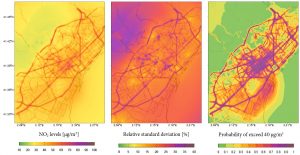April 25, 2023 — Ninety-nine percent of the world’s population breathes air that exceeds the limits recommended by the World Health Organization. This scenario is exacerbated in urban areas where more than 50% of the world’s population is concentrated. To mitigate the problem of air pollution, considered by the WHO to be the main environmental risk factor for health worldwide, it is crucial to have more reliable and accurate data on the concentration of air pollutants in our cities, especially nitrogen dioxide (NO2) because of its harmful effects on people’s quality of life and the associated economic consequences.

To advance in this line of research, a team of scientists from the Earth System Services group of the Earth Sciences Department at the Barcelona Supercomputing Center – Centro Nacional de Supercomputación (BSC-CNS) has carried out a study that shows that artificial intelligence can be of great use in obtaining reliable information on the probability of exceeding legal limits for air pollution throughout the city. The aim of the research, published in the journal Geoscientific Model Development, is to help improve air quality management in urban areas by obtaining hourly maps of NO2 concentrations at the street level, as well as quantifying the associated uncertainty.
The new method combines for the first time the results of CALIOPE-Urban, a unique model in Spain that allows air pollution forecasting at very high resolutions of up to ten metres, at different heights and at any point in the city, with an extensive urban database that includes observations from official air quality stations, low-cost sensor campaigns, information on building density, meteorological variables, and a long list of other geospatial information. In this way, areas of the city where the current monitoring system needs to be improved can be identified, helping to optimise strategies to reduce air pollution.
“The combination of CALIOPE-Urban predictions with all these urban data using artificial intelligence allows us to improve the model because where simulation cannot explain the spatial distribution of pollution, we can use machine learning to correct and improve this prediction,” said Jan Mateu, leader of the BSC Air Quality Services team and one of the main authors of the study.
The use of machine learning techniques with observational data obtained during previous campaigns using passive dosimeters represents an important advance, as it reduces the inherent uncertainties associated with air quality models due to the low density of monitoring stations. This provides a better spatial characterization of excess air pollution in different parts of the city.
One of the main conclusions of the study, which in this pilot phase focused on the city of Barcelona, is that the district with the worst air quality in the Catalan capital is the Eixample, where 95% of its area has more than a 50% probability of exceeding the annual average NO2 limit of 40 μg/m3 set by the European Commission (European Air Quality Directive 2008/50/EC).
“The Eixample district, the most populated district in Barcelona, is the most affected area in the city, as the vast majority of its surface area has a greater than 50% probability of exceeding the annual NO2 limit set by the European Commission. Thanks to our methodology, the public administration will be able to design and manage policies to improve air quality in urban areas, which is particularly important since air pollution is the main environmental risk factor for human health,” added Álvaro Criado, a researcher in BSC’s Air Quality Services team and one of the main authors of the study.
The CALIOPE-Urban model
Developed at the BSC, CALIOPE-Urban is a modelling tool that estimates the concentration of nitrogen dioxide (NO2) at street level in the city of Barcelona, although it could also be applied to other cities or metropolitan areas. NO2 and its precursors are mainly emitted from combustion sources, such as vehicle engines, so monitoring is crucial to combat air pollution in large cities where traffic is often congested.
The system, which is unique in Spain, provides citizens and air quality managers with useful information on how traffic affects air pollution in each neighbourhood. This information is essential for designing and implementing effective planning and mitigation strategies to protect citizens from the health threats posed by air pollution. CALIOPE-Urban is currently focused on the city of Barcelona, but work is already underway to extend it to other municipalities in collaboration with various municipal and regional administrations.
CALIOPE-Urban combines the technology of the CALIOPE regional model, the BSC air quality prediction system, with an urban model that considers air pollution at street level, using information on traffic emissions and meteorological data. CALIOPE, the only air quality system that provides operational forecasts for Barcelona, Catalonia, the Iberian Peninsula and Europe, is the sole Spanish contributor to the European Union’s Copernicus Atmosphere Monitoring Service (CAMS).
Reference: Criado, A., Armengol, J. M., Petetin, H., Rodriguez-Rey, D., Benavides, J., Guevara, M., Pérez García-Pando, C., Soret, A., and Jorba, O.: Data fusion uncertainty-enabled methods to map street-scale hourly NO2 in Barcelona: a case study with CALIOPE-Urban v1.0, Geosci. Model Dev., 16, 2193–2213, https://doi.org/10.5194/gmd-16-2193-2023, 2023.
About BSC
Barcelona Supercomputing Center-Centro Nacional de Supercomputación (BSC-CNS) is the national supercomputing center in Spain. The center is specialized in high performance computing (HPC) and manages MareNostrum, one of the most powerful supercomputers in Europe, located in the Torre Girona chapel.
Source: BSC-CNS


























































